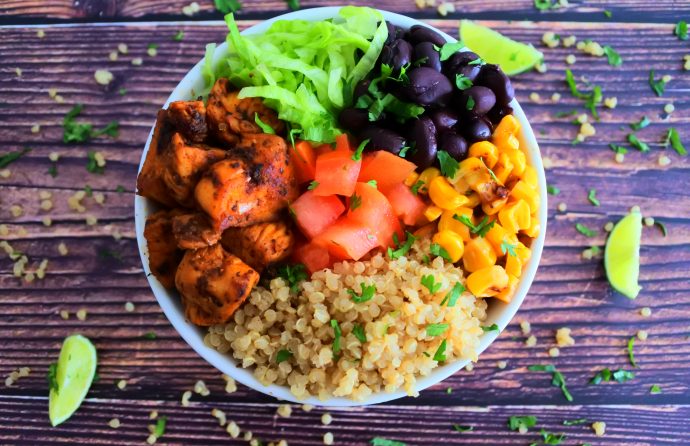Disclosure: This post may contain affiliate links.
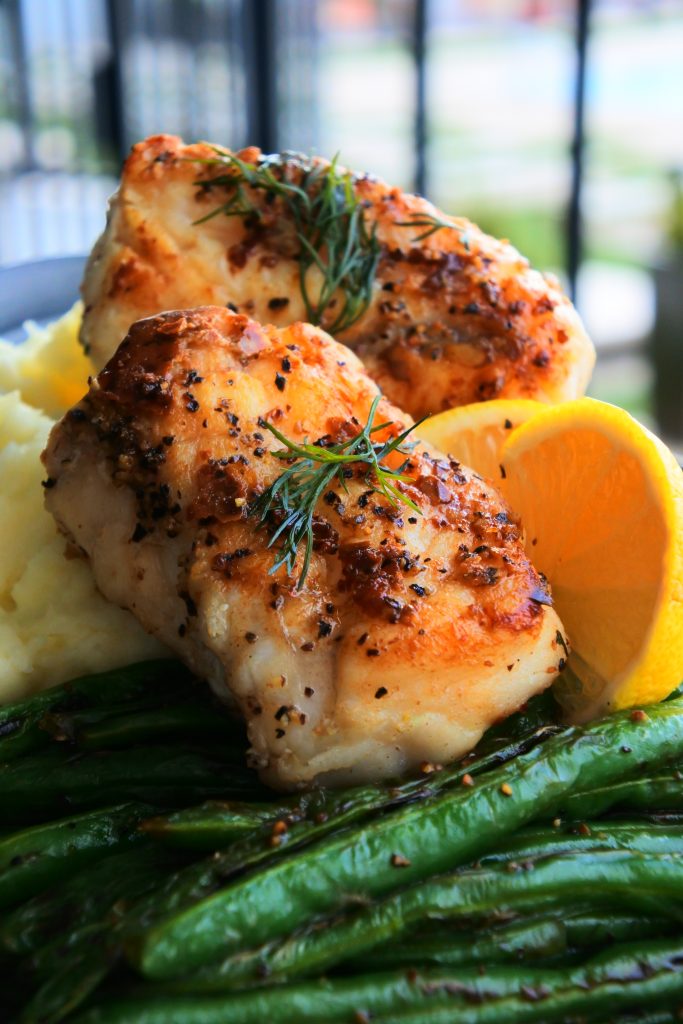
With a firm and meaty texture, and a mild and sweet flavor profile with little to no fishiness, monkfish has rightfully earned the title of “the poor man’s lobster”.
What is Monkfish?
Found in the bottom-most depths of the waters that span all the way from coastal Norway to the Northern Atlantic, the monkfish, a type of anglerfish, might seem a bit terrifying upon first glance as it uses its fins to crawl along the ocean floor and bury its mottled and spiked scaleless brown/black body in the sediment. Near invisible, the only tell-tale sign of its presence is the long thin, antenna-like rod jutting out of the top of its head. This rod serves the dual purpose of detecting and attracting prey while the fish itself patiently waits, tensed and ready to move in a quick and explosive lunge, maw opening to reveal sharp teeth snapping in its large flat head at any meal that happens by.
What Does Monkfish Taste Like?
Don’t let this terrifying description of the monkfish throw you off. Monkfish are highly sought after for their clean, firm, and sweet meat that is often compared to lobster (but pricewise, it’s more than three times cheaper per lb!). Often caught, processed, and sold as fillets or medallions, it’s rare that you can buy the whole fish since only the tail and cheeks are viable eats. When purchasing the fillets, you’ll want to be sure that that pinkish membrane is removed and that the fillets have a pearl-white sheen to them with little to no bruise-like discolorations. The meat should be firm with no fishy smell to it.
Given that this fish isn’t fragile, flaky, or delicate, it stands up well to almost any cooking method be it baking, poaching, grilling, or pan-frying. Today we’re going to treat it almost like a steak– we’ll sear it off in a skillet and finish it with an herbed butter-basting for a bite of pure (but affordable) decadence. Sounds good, right?
Is Monkfish Healthy?
In short, yes! Monkfish is a lean fish, meaning it’s low in calories (about 120 per 6oz serving), high in protein (about 24g per 6oz serving) and low in fat (about 2.2g total fat per 6oz serving), while containing numerous vitamins, minerals and antioxidants including B6, B12, Magnesium, Prosperous, Selenium, Niacin, and trace elements of Vit A and C, Calcium, Iron, Zinc, Copper, Manganese, Thiamine, Riboflavin and Folate.
Ingredients Needed For Pan-Fried Monkfish:
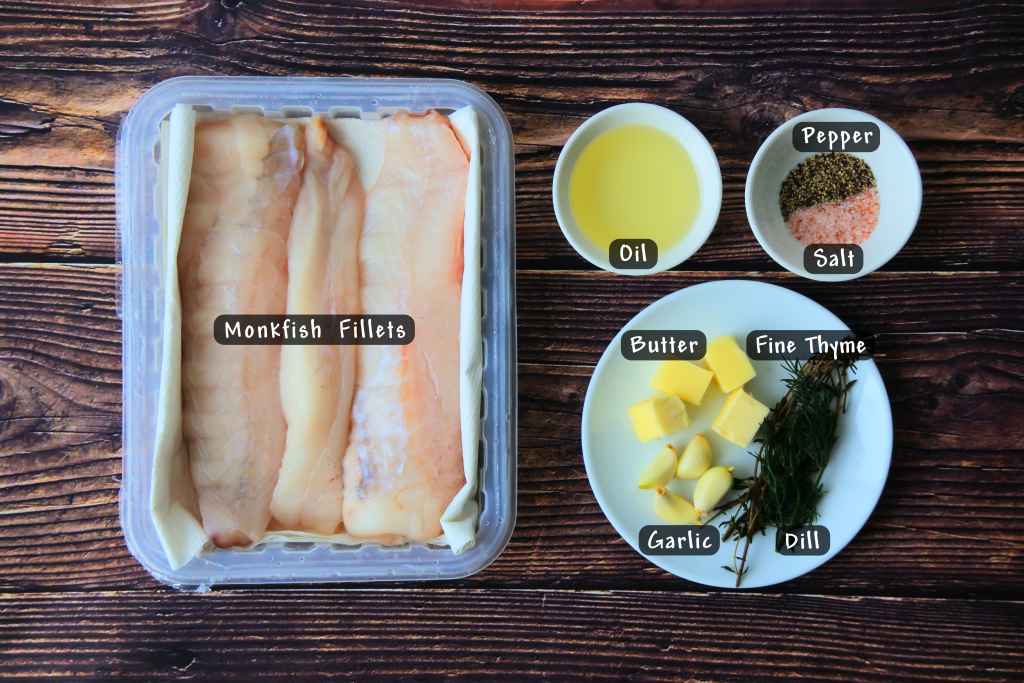
- Monkfish Fillets: Tail or cheek meat, you’ll most likely be able to purchase fillets that are deboned and ready to be used with little to no prep.
- Salt: Himalayan salt or sea salt works fine.
- Pepper: Fresh or pre-ground black pepper works.
- Oil: Opt to use a neutral-flavored, clean eating, high smoke point oil such as peanut or even ghee.
- Butter: I’m using cubes of salted butter but you can use unsalted if you prefer
- Garlic: Several fresh cloves of garlic are needed. We’ll crush the cloves before adding them to the pan.
- Fine Thyme Sprigs: We’ll be using a spring of fine thyme for flavor.
- Dill: I’m using a couple sprigs of fresh dill and a few more pieces to garnish.
- Lemon Wedges: Fresh wedges of lemon can be used to serve and garnish.
Let Me Show You How Easy It Is To Pan-Fry Our Fillets:
We’ll start by prepping our fish. To do this you’ll want to rinse your fillets under cold running water and then pat them as dry as possible. I’ve cut my fillets in half to get smaller steak-sized pieces but you can leave them whole if preferred.
Note that in some cases there may be a pinkish membrane around your fillets known as “silver skin” that needs to be removed. Most of the time your fishmonger will remove them for you but if not, removing them is as easy as pinching it at the tail end and peeling it off.
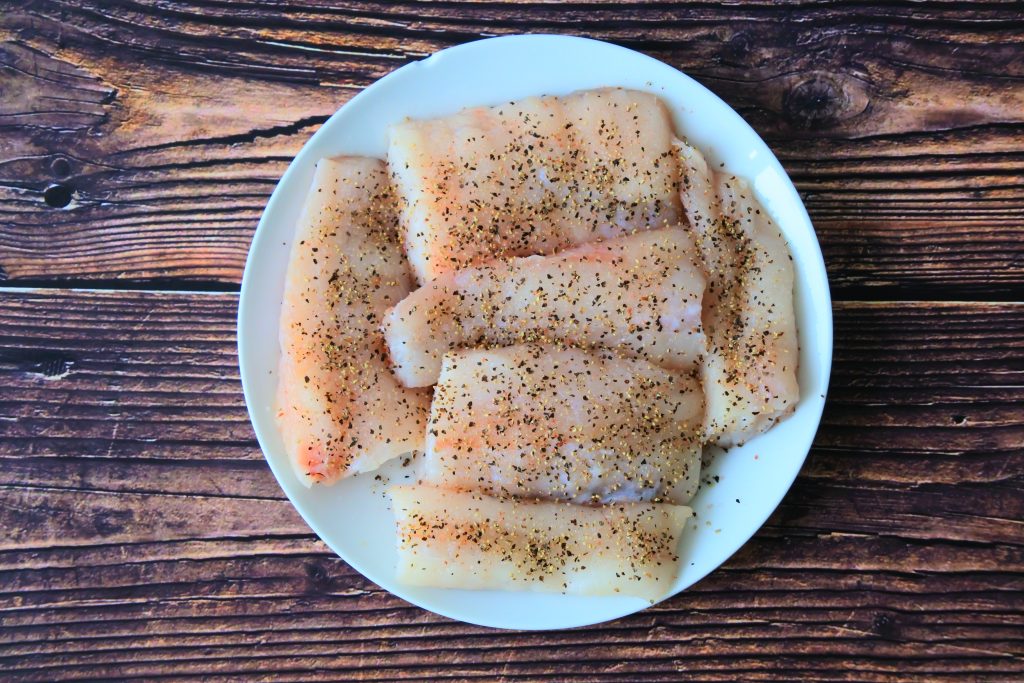
With your fillets rinsed and patted dry, season them with a sprinkle of salt and pepper and allow them to rest for a couple minutes while we heat our pan up.
Now, a quick note: Since monkfish is a very lean meat, the moment it hits the pan it will sizzle and begin to shrink and tighten itself as it loses moisture. If you’d like to avoid this, an easy solution is to soak your monkfish in a brine for an hour before cooking to allow it to absorb more moisture and remain plump when you cook it. Should you brine your fillets, skip the salt seasoning pat your fillets dry and just use pepper to season.

Heat a skillet on high heat and add your oil to the skillet, when the oil is shimmering, but not smoking, add your seasoned fillets to the pan and allow them to cook undisturbed for 2-3 minutes until it has released itself from the skillet and is golden brown.
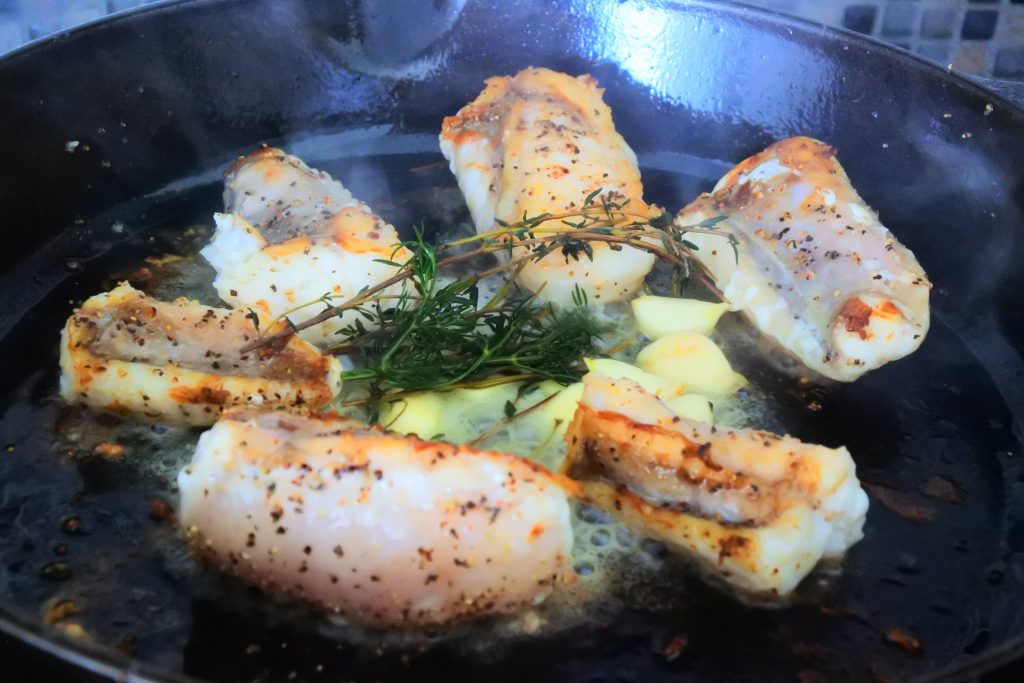
Flip your fish over and add your butter and herbs to the middle of the pan, allowing it to melt and meld together. Once the butter is melted and bubbling around your aromatics, spoon the melted butter over each fillet for 2-3 minutes while the other side browns and cooks.
Turn off the heat, flip your fillets once more and continue to baste for an additional minute.
As you can tell, this fish cooks very fast. If you’re concerned about whether or not they’re fully cooked, measure the internal temperature of the thickest piece, your fish will be cooked when it reaches an internal temperature of 140F, but don’t forget to account for carry over cooking – so you’ll want to remove it from the heat when it gets to about 130-135F.
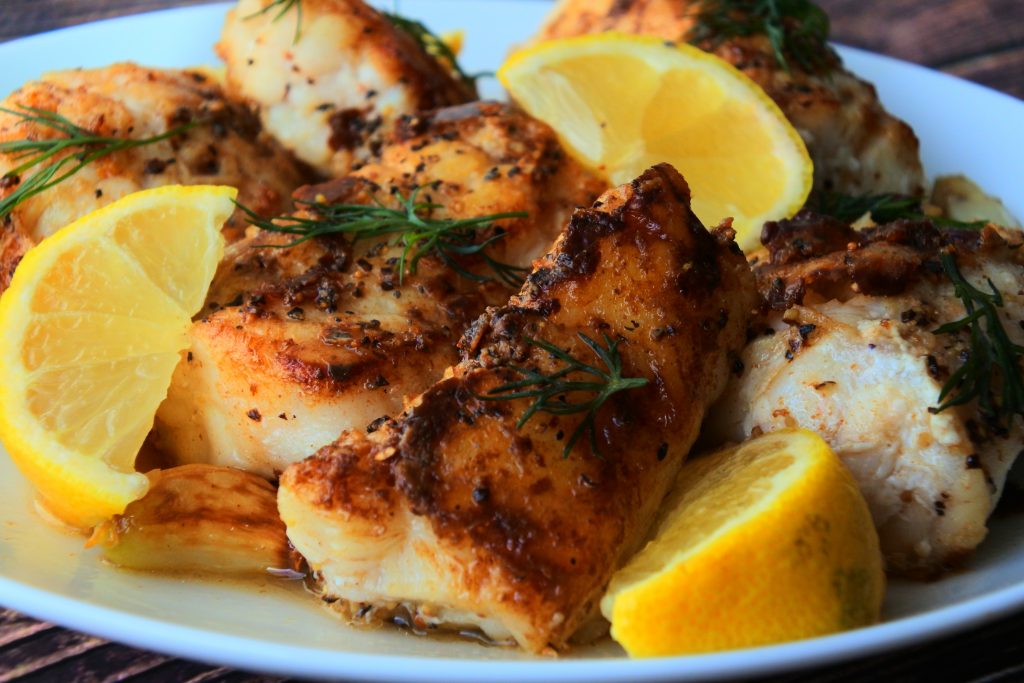
Then, remove your fillets to a clean plate and allow them to rest for at least 5 minutes. If you dig in right away, the texture will be rubbery, but in allowing them to rest, the protein fibers can relax which will allow your fish to be tender and succulent.

Plate and serve your fillets with your favorite sides and pairings. Today I’m keeping it simple and classic with a serving of smoky green beans and creamy mashed potato.
Some other great sides to serve with your fillets include:
- Roasted Garlic Parmesan Mashed Potatoes or for a lower carb option, this easy Cauliflower Mash.
- Skillet Fried Potatoes.
- Twice Baked Potatoes with Leeks.
- A Simple Veggie Tray Bake.
- Sautéed Broccolini.
- Simple Coconut Saffron Rice.
- Cheesy Butternut Squash with Bacon.
- Or maybe the classic fish taco served on a homemade corn tortilla is the perfect pairing for you?
However you choose to enjoy this simple pan-fried delicacy, you can’t go wrong.

I’ve garnished my fillets with fresh dill and wedges of lemon to round out my meal and now all that’s left to do is to dig in and enjoy. Tender, succulent, buttery, and perfectly seasoned, this isn’t going to be a bite of your everyday run-of-the-mill fish. I hope you give this recipe a try and if you do, don’t forget to rate it and let us know what you thought about it? Is this your first time trying monkfish? What did you think of it compared to other fishes? Let us know below!
Pan-Fried Monkfish Fillets - The Poor Man's Lobster
Ingredients
- 4 fillets monkfish
- 1 tsp Himalayan salt (to taste)
- 1 tsp ground black pepper (to taste)
- 2 tbsp peanut oil or ghee
- 2 tbsp salted butter
- 2-4 cloves garlic crushed
- 1 sprig fine thyme
- 1 sprig fresh dill
- wedges fresh lemon to garnish
Instructions
- Rinse your fillets under cold, running water. If there is any pinkish membrane on your monkfish, be sure to peel it off.
- Pat each fillet completely dry and season all sides with salt and pepper.
- Heat a skillet on high heat, and once hot, add the oil. Once the oil is shimmering but not smoking, add your fillets and do not disturb them for 2-3 minutes.
- Once the undersides are browned and release from the pan, flip your fillets over and add the butter and herbs to the middle of the pan. Once the butter has melted and has bubbled around the herbs for 30 seconds, begin to spoon the mixture over each fillet.
- 2-3 minutes after you flipped your fillets over, remove your pan from the heat and flip them one final time and butter baste them for an additional minute.
- Move the fillets to a plate and allow them to rest for 5 minutes before serving.
- Serve and enjoy immediately.
Notes
- Monkfish is a lean meat so it will shrink when it hits the pan. To avoid shrinkage, you can soak your fillets in a brine solution for an hour before cooking. If you do this, be sure to skip the salt seasoning and just use black pepper after you remove each fillet from the brine and pat it dry.
- Ensure you're using a high smoke point oil. Great options are peanut oil or ghee.
- This fish cooks very fast. If you're concerned about whether or not they're fully cooked, measure the temperature of the thickest piece, your fish will be cooked when it reaches an internal temperature of 140F, but don't forget to account for carry over cooking - so you'll want to remove it from the heat when it gets to about 135F. Overcooked monkfish can be tough and rubbery.

